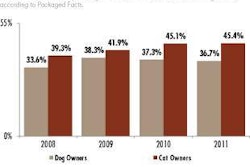The global corn harvest may set another record this year, with a 9% increase in yield over the 2011 crop, itself a record, according to Dr. Joseph Glauber, chief economist at the US Department of Agriculture.* The rise in the global crop is being driven by an almost 20% increase in the US harvest, he said.
Presenting at the 2012 annual conference of the International Grains Council, Glauber reported that current data shows US corn growers have planted about 96.37 million acres, the largest area since 1937. USDA analysts also estimate that this 4%+ increase in planting, combined with a 6% jump in harvested area and nearly 13% rise in yield, will result in production of 14.8 billion bushels of corn in the US alone for the 2012-13 harvest year. That's up from the record 12.4 billion bushels in 2011-2012.
And those numbers keep going up from previous predictions in early March and even the end of April, not quite two months ago. When the next official report comes out next week, at the end of June, will the numbers be even higher? Global corn production overall is up, too, with USDA projecting an increase of 4.2 million tons to a total of 949.9 million tons.
Besides the increase in planting and yield, Glauber also attributed the rise in grain stocks to the lack of growth of corn use by US ethanol plants in 2012-13 -- which would mark the third consecutive year of flat demand from biofuel producers. (You can watch a video of Glauber's remarks on WattAgnet.com.)
The increasing supply of corn has helped moderate its prices. Yet that could change -- so could the supply* -- as huge global food producers like Tyson Foods change their practices due to changes in the grain market. Last week Tyson announced it had stopped using wheat in its poultry feed because the price of wheat has surpassed that of corn. The large poultry producer had switched to wheat in 2011 when wheat prices fell below corn prices for the first time in 15 years.
This year, USDA is projecting feed and residual use of wheat to be the highest in four years, up 50 million bushels from last year for a total of 230 million bushels. China just made its largest purchase of winter wheat since 2004, buying 110,000 metric tons of soft red winter wheat from the US as its own production is likely to decline.
All this goes to show just how interdependent different ingredients within the commodity market are on one another. And they, in turn, affect supply, demand and prices of other ingredients. For example, availability and pricing of the chicken or turkey many petfood companies use in their formulations are often affected by the markets for the grains that poultry are fed.
So, even though the grain-free category in petfood is proliferating -- the number of grain-free products on display at Interzoo by petfood companies from all over the world was testament to that -- petfood manufacturers are wise to pay attention to how all the grain and other ingredient markets are doing. Whether your formulations include such ingredients, it's likely you will experience the effects if their supplies plummet or prices soar.
*Updated July, 3, 2012: According to recent reports, extremely high temperatures and a drought in the US Midwest may now jeopardize the corn crop. USDA has decreased its yield forecast 4%, or 1 billion bushels, and says 8% of the corn land will not be harvested.
















